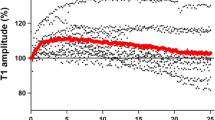Abstract
With double burst stimulation (DBS) it is possible to monitor more profound degrees of neuromuscular blockade than with train-of-four stimulation (TOF). It may therefore be indicated to change between DBS and TOF stimulation during moderate to profound degrees of neuromuscular blockade. Consequently, the aim of the study was to evaluate and compare the twitch height of the first twitch (D1) in DBS and the twitch height of the first twitch (T1) in TOF stimulation during moderate to profound degrees of neuromuscular blockade. Thirty-three patients scheduled for gynaecological laparotomy under general anaesthesia were studied. Mechanomyography was used for neuromuscular monitoring. The T1 twitch height before atracurium was administered served as the control twitch height (T1 control). T1 control was considered as 100%. A constant degree of neuromuscular blockade was maintained at a T1 twitch height at a point between 4 and 11% of T1 control, using a continuous infusion of atracurium. Sequences of 16 DBS and 16 TOF stimulations were given. Two different DBS patterns were examined: DBS3,350/50, (3 stimuli at 50 Hz followed 0.75 sec later by 3 stimuli at 50 Hz), and DBS3,380/40, (3 stimuli at 80 Hz followed 0.75 sec later by 3 stimuli at 40 Hz). The data were analysed by the method described by Bland and Altman (1). The D1 repeatability coefficients of 1.72% for DBS3,350/50 and 1.20% for DBS3,380/40 were significantly greater than the repeatability coefficient of 1.02% for T1 (p<0.05). The D1 bias of 16.7% for DBS3,350/50 was significantly less than the D1 bias of 25.7% for DBS3,380/40 (p<0.05). The limits of agreement between D1 and T1 were 0.1 to 33.3% for DBS3,350/50 and 2.9 to 48.5% for DBS3,380/40. In conclusion: The repeatability of responses to DBS and TOF stimulations during moderate to profound degrees of neuromuscular blockade where only one twitch is consistently present is satisfactory. The responses to DBS were greater than responses to TOF as indicated by a positive bias of DBS. The limits of agreement between DBS and TOF responses were so wide that they cannot be used interchangeably.
Similar content being viewed by others
References
Bland JM, Altman DG. Statistical methods for assessing agreement between two methods of clinical measurement. Lancet 1986; 1: 307–310.
Howardy-Hansen P, Viby-Mogensen J, Gottschau A, Skovgaard LT, Chræmmer-Jørgensen B, Engbæk J. Tactile evaluation of the posttetanic count (PTC). Anesthesiology 1984; 60: 372–374.
Engbæk J, Østergaard D, Viby-Mogensen J. Double burst stimulation (DBS): a new pattern of nerve stimulation to identify residual neuromuscular block. Br J Anaesth 1989; 62: 274–278.
Drenck NE, Ueda N, Olsen NV et al. Manual evaluation of residual curarization using double burst stimulation. Anesthesiology 1989; 70: 578–581.
Gill SS, Donati F, Bevan DR. Clinical evaluation of double burst stimulation. Its relationship to train-of-four stimulation. Anaesthesia 1990; 45: 543–548.
Saddler JM, Bevan JC, Donati F, Bevan DR, Pinto SR. Comparison of double-burst and train-of-four stimulation to assess neuromuscularblockade in children. Anesthesiology 1990; 73: 401–403.
Ueda N, Muteki T, Tsuda H, Inoue S, Nishina H. Is the diagnosis of significant residual neuromuscular blockade improved by using double-burst nerve stimulation? Eur J Anaesthesiol 1991; 8: 213–218.
Brull SJ, Silverman DG. Visual and tactile assessment of neuromuscular fade. Anesth Analg 1993; 77: 352–355.
Braude N, Vyvyan HAL, Jordan MJ. Intraoperative assessment of atracurium-induced neuromuscular block using double burst stimulation. Br J Anaesth 1991; 67: 574–578.
Kirkegaard-Nielsen H, May O. Double burst stimulation for monitoring profound neuromuscular blockade: a comparison with posttetanic count and train-of-four. Acta Anaesth Belg 1992; 43: 253–257.
Kirkegaard-Nielsen H, May O. The influence of the double burst stimulation (DBS) pattern on the DBS—train-of-four ratio relationship. Anästhesiologie Intensivmedizin Notfallmedizin Schmerztherapie 1995; 30: 163–166.
British Standard Institution. Precision of test methods, part 1. Guide for the determination of repeatability and reproducibility for a standard test method by inter-laboratory tests. London: British Standards Institution, BS 5497, 1987.
Jensen E, Werner M, Viby-Mogensen J. Bilateral measurement (BM) of neuromuscular blockade using mechanomyography. Anesthesiology 1989; 71: A823.
Kirkegaard-Nielsen H, Helbo-Hansen HS, Lindholm P, Severinsen IK, Bülow K, Jensen EW. Stabilization of the neuromuscular response when switching between different modes of nerve stimulation at surgical degrees of neuromuscular blockade. Journal of Clinical Monitoring; in press.
Westgard JO, Hunt MR. Use and interpretation of common statistical tests in method-comparison studies. Clinical Chemistry 1973; 19: 49–57.
Fraser CG. Interpretation of clinical chemistry laboratory data (first ed.) Oxford: Blackwell Scientific Publications Ltd., 1986
Helbo-Hansen HS, Bang U, Kirkegaard-Nielsen H, Skovgaard LT. The accuracy of train-of-four monitoring at varying stimulation current. Anesthesiology 1992; 76: 199–203.
Harper NJN, Martlew R, Strang T, Wallace M. Monitoring neuromuscular block by acceleromyography; comparison of the Mini-Accellograph with the Myograph 2000. Br J Anaesth 1994; 72: 411–414.
Altman DG, Bland JM. Measurement in medicine; the analysis of method comparison studies. The Statistician 1983; 32: 307–317.
LaMantia KR, O'Connor T, Barash PG. Comparing methods of measurement: An Alternative Approach. Anesthesiology 1990; 72: 781–783.
Cronbach LJ. Coefficient alpha and the internal structure of tests. Psychometrika 1951; 16: 297–334.
Cohen J. A coefficient of agreement for nominal scales. Educ Psychol Measurement 1960; 20: 37–46.
Martin HF, Gudzinowicz BJ, Fanger H. Normal values in clinical chemistry. A guide to statistical analysis of laboratory data, 122–123, ed. Schwartz MK. New York: Marcel Dekker Inc., 1975.
Wong DH, Tremper KK, Stemmer EA, et al. Noninvasive cardiac output: Simultaneous comparison of two different methods with thermodilution. Anesthesiology 1990; 72: 784–792.
Author information
Authors and Affiliations
Rights and permissions
About this article
Cite this article
Kirkegaard-Nielsen, H., Helbo-Hansen, H.S., Lindholm, P. et al. Double burst monitoring during surgical degrees of neuromuscular blockade: A comparison with train-of-four. J Clin Monitor Comput 12, 191–196 (1995). https://doi.org/10.1007/BF01207198
Accepted:
Issue Date:
DOI: https://doi.org/10.1007/BF01207198




